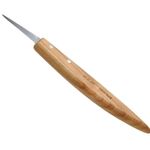Lapped Dovetails Are the Right Joint for a Top Rail
Learn why a lapped dovetail is a better joint than a mortise and tenon for joining a top rail to table legs.

Q: In carcase and table construction, I often see a lapped dovetail joint connecting a top rail to the legs. Why is this joint preferred over mortise-and-tenon joinery?
John Dennis, Temple, NH
A: Lapped dovetails are used on a narrow rail above a door or drawer, where there isn’t enough thickness for a strong mortise-and-tenon joint. A kick to the bottom of the leg, or the act of repeatedly sliding the table across a floor, creates racking forces at the top that want to pull the leg away from the rail. The lapped dovetail really shines here, because it has a mechanical advantage over mortise-and-tenon joinery. The angled sides of the tail pull the joint tight and lock it together, which means it can’t pull apart, even if the glue fails. A single lap is strong, but I think a double lapped dovetail, in which the upper rail is joined to the leg and side apron, is stronger. Because a double lapped dovetail requires a wider rail and has two locking joints, it resists racking forces even better.
Why small tenons on the top rail are a bad idea
Because the tenon is in line with the forces working to pull the joint apart and offers no mechanical resistance to them, you’re relying on your ability to fit the joint and the strength of the glue to keep the joint together.
Single lapped dovetail locks the parts together
Angled sides prevent the tail from pulling out of the socket and provide resistance to racking forces in every direction.
Double lapped dovetail is even stronger
Having two tails on a wide rail makes the base even stronger. Use this version of the joint when possible.

Illustrations: Kelly J. Dunton
From Fine Woodworking #234
Fine Woodworking Recommended Products

Pfiel Chip Carving Knife

Veritas Precision Square

Suizan Japanese Pull Saw










Log in or create an account to post a comment.
Sign up Log in